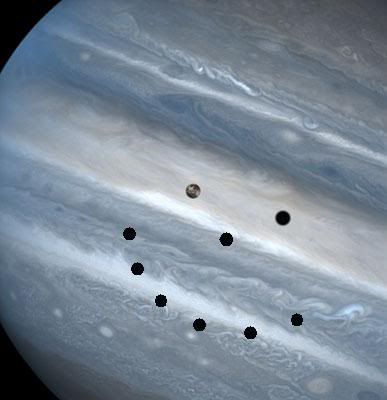
Have a nice day.
Posted on 09/02/2006 3:19:24 AM PDT by Virginia-American
A tiny moon has been caught floating in front of Uranus for the first time, the Hubble Space Telescope reveals. The moon's shadow can also be seen on the planet's cloud tops, creating a solar eclipse on Uranus itself.
Hubble imaged the event unexpectedly in July 2006, during a set of observations meant to study the planet's clouds. "When we first got this image back, we looked at it and said, 'What's that bright spot and that dark spot?'" says team member Heidi Hammel of the Space Science Institute in Boulder, Colorado, US. "We thought, it must be a problem with the detector."
Then, recognising that it resembled "transit" events seen fairly frequently around other giant planets, such as when Jupiter's moon Io passes in front of that planet's disc, the researchers realised they had seen the first ever transit on Uranus. It featured the 1130 kilometre-wide (700 mile-wide) Ariel, one of the planet's 27 moons.
The events are so rare because Uranus, unlike the solar system's other planets, is tilted almost completely on its side, with its rotational axis lying nearly in its orbital plane.
Its moons, however, orbit the icy giant above its equator. So when either of Uranus's poles is facing the Sun during the planet's 84-year orbit, the moons do not cross its disc at all as seen from Earth. Instead, they circle it on orbits that resemble the rings around a bull's eye.
Rare chance
Uranus, its moons and the Sun are only in the right alignment to observe the effect every 42 years. Now, Uranus is approaching such an ideal viewing period – it will reach its equinox, in which the Sun will shine directly over the planet's equator, in 2007. "This is a once-in-a-career event for most of us," Hammel told New Scientist.
It is also the first time in the history of astronomy that such observations are even possible. When the planet's equinox last occurred, in 1965, existing telescopes were simply not powerful enough to resolve the transits. Even today, only two or three telescopes can image them, including Hubble.
"This planet and its system of rings and moons and magnetic fields are so far away, we need the biggest and best telescopes on Earth to do a lot of the observations," Hammel explains.
In fact, the planet is so far away that even the best telescopes do not have vision sharp enough to determine the moons' sizes simply by imaging them. "They're so far away, they're just points of light," Hammel continues.
But during equinoxes, astronomers can gauge the moons' sizes by observing the moons passing in front of each other or into each other's shadows. "By looking at how long it takes for the secondary satellite to go into and out of eclipse, we can figure out the size of the first moon, which is casting the shadow," she says. Knowing the moons' physical sizes reveals their mass and clues about their history, she says.
"It's very exciting," Hammel told New Scientist. "We're really hoping we get enough telescope time to do what we need to do."

Reuter's exclusive! Looks like an Israeli space crime to me!
The sun is really bright there, I bet you could get a sunburn on.. you know...
Perhaps they have just enough computer time to do their stated work--taking up more computer time to work out the positions of 27 moons that have no bearing on their work might be a violation of their grant...just guessing here, perhaps computer time is a lot more plentiful than it used to be, but I still think we need more info before trashing these stargazers as imcompetents.
LOL
Pluto ....... relegated to just being man's best friend.
Not so bad.
Thanks for the ping!
"I just took this great photo of Uranus. Wanna see it?"
Cheers!
You're welcome to your opinion, but I would expect better knowledge of the subject matter than that exhibited in the article..
I'll give you this.. It may have been the reporter(s) that are mis-stating the situation / circumstances..
At any rate, knowing the albedo of one of the moons and observing it for changes as it orbits behind the planet would give indication of such things as the height and density of the atmosphere and cloud cover..
Additionally, the shadow cast upon said cloud cover could also provide information on cloud height and density...
I would bet that any stars that pass behind the planet are also observed to determine atmospheric characteristics..
Must.
Not.
Make.
Obvious.
Joke.
Must.
Not.
Make.
Obvious.
Joke.
Must.
Not.
Make.
Obvious.
Joke.
LOL ...... is that Vonnegut?
from: http://skytonight.com/news/home/3823426.html
Really great to see this..thanks for the posting and pic.
You're welcome. I knew there would be a bunch of stupid puns, but the pic really impressed me. I hope NASA has sense enough to keep the HST working; it's produced a lot more science than the space station.
Dark skies reveal planet Uranus
http://msnbc.msn.com/id/14739540/
Note: this topic is from 01 September 2006. Thanks Virginia-American.
 |
||
| · join · view topics · view or post blog · bookmark · post new topic · subscribe · | ||
| Google news searches: exoplanet · exosolar · extrasolar · | ||
Disclaimer: Opinions posted on Free Republic are those of the individual posters and do not necessarily represent the opinion of Free Republic or its management. All materials posted herein are protected by copyright law and the exemption for fair use of copyrighted works.